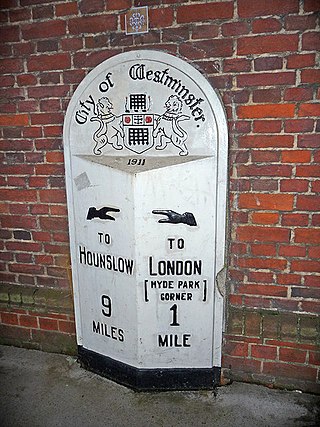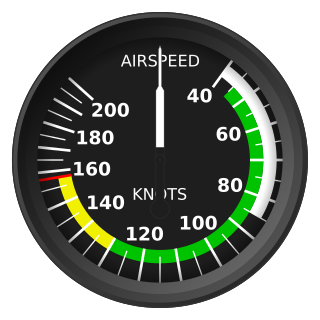The geographical mile is an international unit of length determined by 1 minute of arc along the Earth's equator. For the international ellipsoid 1924 this equalled 1855.4 metres. The American Practical Navigator 2017 defines the geographical mile as 6,087.08 feet (1,855.342 m). Greater precision depends more on the choice of the Earth's radius of the used ellipsoid than on more careful measurement, since the radius of the geoid varies more than 100 metres (328.084 ft) along the equator. In any ellipsoid, the length of a degree of longitude at the equator is exactly 60 geographical miles. The Earth's radius at the equator in the GRS80 ellipsoid is 6,378,137.0000 m, which makes the geographical mile 1,855.3248 m. The rounding of the Earth's radius to metres in GRS80 has an effect of 0.0001 m.

The imperial system of units, imperial system or imperial units is the system of units first defined in the British Weights and Measures Act 1824 and continued to be developed through a series of Weights and Measures Acts and amendments.

The mile, sometimes the international mile or statute mile to distinguish it from other miles, is a British imperial unit and United States customary unit of distance; both are based on the older English unit of length equal to 5,280 English feet, or 1,760 yards. The statute mile was standardised between the British Commonwealth and the United States by an international agreement in 1959, when it was formally redefined with respect to SI units as exactly 1,609.344 metres.
A nautical mile is a unit of length used in air, marine, and space navigation, and for the definition of territorial waters. Historically, it was defined as the meridian arc length corresponding to one minute of latitude. Today the international nautical mile is defined as 1,852 metres. The derived unit of speed is the knot, one nautical mile per hour.

United States customary units form a system of measurement units commonly used in the United States and most U.S. territories, since being standardized and adopted in 1832. The United States customary system developed from English units that were in use in the British Empire before the U.S. became an independent country. The United Kingdom's system of measures was overhauled in 1824 to create the imperial system, which was officially adopted in 1826, changing the definitions of some of its units. Consequently, while many U.S. units are essentially similar to their imperial counterparts, there are significant differences between the systems.

A fathom is a unit of length in the imperial and the U.S. customary systems equal to 6 feet (1.8288 m), used especially for measuring the depth of water. The fathom is neither an international standard (SI) unit, nor an internationally accepted non-SI unit. Historically it was the maritime measure of depth in the English-speaking world but, apart from within the USA, charts now use metres.

The knot is a unit of speed equal to one nautical mile per hour, exactly 1.852 km/h. The ISO standard symbol for the knot is kn. The same symbol is preferred by the Institute of Electrical and Electronics Engineers (IEEE), while kt is also common, especially in aviation, where it is the form recommended by the International Civil Aviation Organization (ICAO). The knot is a non-SI unit. The knot is used in meteorology, and in maritime and air navigation. A vessel travelling at 1 knot along a meridian travels approximately one minute of geographic latitude in one hour.

Metrication is the process of introducing the International System of Units, also known as SI units or the metric system, to replace a jurisdiction's traditional measuring units. U.S. customary units have been defined in terms of metric units since the 19th century, and the SI has been the "preferred system of weights and measures for United States trade and commerce" since 1975 according to United States law. However, conversion was not mandatory and many industries chose not to convert, and U.S. customary units remain in common use in many industries as well as in governmental use. Unlike other countries, there is no governmental or major social desire to implement further metrication.

A verst is an obsolete Russian unit of length defined as 500 sazhen. This makes a verst equal to 1.0668 kilometres.
A system of measurement is a collection of units of measurement and rules relating them to each other. Systems of measurement have historically been important, regulated and defined for the purposes of science and commerce. Systems of measurement in use include the International System of Units or SI, the British imperial system, and the United States customary system.
The following systems arose from earlier systems, and in many cases utilise parts of much older systems. For the most part they were used to varying degrees in the Middle Ages and surrounding time periods. Some of these systems found their way into later systems, such as the Imperial system and even SI.
A league is a unit of length. It was common in Europe and Latin America, but is no longer an official unit in any nation. Derived from an ancient Celtic unit and adopted by the Romans as the leuga, the league became a common unit of measurement throughout western Europe. Since the Middle Ages, many values have been specified in several countries.

Li, also known as the Chinese mile, is a traditional Chinese unit of distance. The li has varied considerably over time but was usually about one third of an English mile and now has a standardized length of a half-kilometer. This is then divided into 1,500 chi or "Chinese feet".

A milliradian is an SI derived unit for angular measurement which is defined as a thousandth of a radian (0.001 radian). Milliradians are used in adjustment of firearm sights by adjusting the angle of the sight compared to the barrel. Milliradians are also used for comparing shot groupings, or to compare the difficulty of hitting different sized shooting targets at different distances. When using a scope with both mrad adjustment and a reticle with mrad markings, the shooter can use the reticle as a ruler to count the number of mrads a shot was off-target, which directly translates to the sight adjustment needed to hit the target with a follow up shot. Optics with mrad markings in the reticle can also be used to make a range estimation of a known size target, or vice versa, to determine a target size if the distance is known, a practice called "milling".

The Dutch units of measurement used today are those of the metric system. Before the 19th century, a wide variety of different weights and measures were used by the various Dutch towns and provinces. Despite the country's small size, there was a lack of uniformity. During the Dutch Golden Age, these weights and measures accompanied the Dutch to the farthest corners of their colonial empire, including South Africa, New Amsterdam and the Dutch East Indies. Units of weight included the pond, ons and last. There was also an apothecaries' system of weights. The mijl and roede were measurements of distance. Smaller distances were measured in units based on parts of the body – the el, the voet, the palm and the duim. Area was measured by the morgen, hont, roede and voet. Units of volume included the okshoofd, aam, anker, stoop, and mingel. At the start of the 19th century the Dutch adopted a unified metric system, but it was based on a modified version of the metric system, different from the system used today. In 1869, this was realigned with the international metric system. These old units of measurement have disappeared, but they remain a colourful legacy of the Netherlands' maritime and commercial importance and survive today in a number of Dutch sayings and expressions.
The units of measurement of German-speaking countries consist of a variety of units, with varying local standard definitions. While many were made redundant with the introduction of the metric system, some of these units are still used in everyday speech and even in stores and on street markets as shorthand for similar amounts in the metric system. For example, some customers ask for one pound of something when they want 500 grams.
As in the case of the Danes the Norwegians' earliest standards of measure can be derived from their ship burials. The 60-Norwegian-feet-long Kvalsund ship was built ca. 700 AD and differs from the Danish boats less than it does from the Oseberg, Gokstad and Tune ships which all date from ca. 800 AD. Thwarts are typically spaced about 3 Norwegian feet apart.
Traditional Swedish units of measurement were standardized by law in 1665, prior to which they only existed as a number of related but differing local variants. The system was slightly revised in 1735. In 1855, a decimal reform was instituted that defined a new Swedish inch as 1⁄10 Swedish foot. Up to the middle of the 19th century, there was a law allowing the imposition of the death penalty for falsifying weights or measures. Sweden adopted the metric system in 1889, after a decision by the parliament in 1875 and a ten-year transition period from 1879. Only the Swedish mile, mil, has been preserved, now measuring 10 kilometres.

A Scandinavian mile is a unit of length common in Norway and Sweden, but not Denmark. Today, it is standardised as 1 mil being 10 kilometres, but it had different values in the past.










